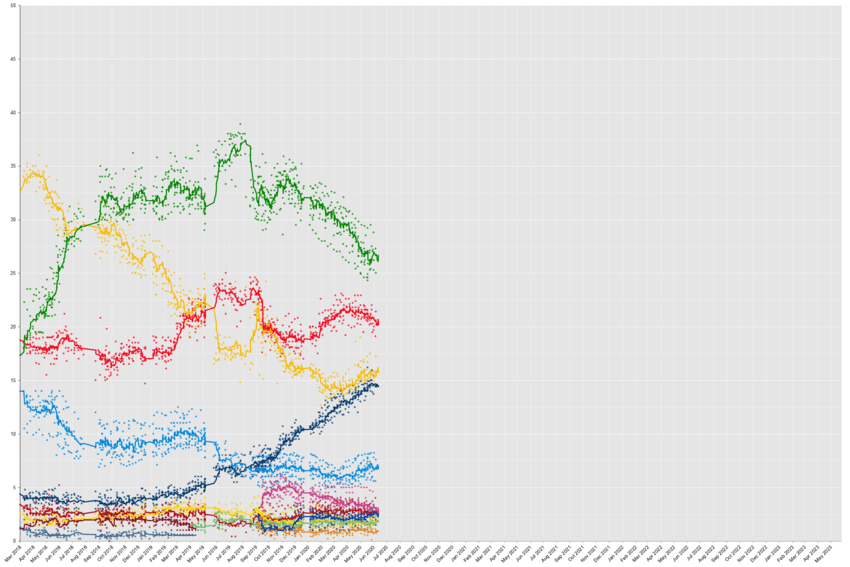Next Italian general election
The next Italian general election is due to be held no later than 28 May 2023.
| |||||||||||||||||||||||||||||
630 seats in the Chamber of Deputies (C), 315 (out of 321) in the Senate (S) 316 (C) and 161 (S) seats needed for a majority | |||||||||||||||||||||||||||||
|---|---|---|---|---|---|---|---|---|---|---|---|---|---|---|---|---|---|---|---|---|---|---|---|---|---|---|---|---|---|
| Opinion polls | |||||||||||||||||||||||||||||
| |||||||||||||||||||||||||||||
| |||||||||||||||||||||||||||||
Under the current Constitution, voters would elect 630 members of the Chamber of Deputies and 315 members of the Senate of the Republic for the 19th Parliament of Italy.
Background
In the 2018 Italian general election, no political group or party won an outright majority, resulting in a hung parliament.[4] On 4 March, the centre-right alliance, in which Matteo Salvini's League emerged as the main political force, won a plurality of seats in the Chamber of Deputies and in the Senate, while the anti-establishment Five Star Movement (M5S) led by Luigi Di Maio became the party with the largest number of votes. The centre-left coalition, led by Matteo Renzi, came third.[5] As a result, protracted negotiations were required before a new government could be formed.
The talks between the Five Star Movement and the League resulted in the proposal of the so-called "government of change" under the leadership of university professor Giuseppe Conte, a law professor close to the M5S.[6] After some bickering with President Sergio Mattarella,[7][8] Conte's cabinet, which was dubbed by the media as Western European "first all-populist government", was sworn in on 1 June.[9]
In August 2019, Deputy Prime Minister Matteo Salvini announced a motion of no confidence against Conte, after growing tensions within the majority.[10][11] Many political analysts believe the no confidence motion was an attempt to force early elections to improve Lega's standing in Parliament, ensuring Salvini could become the next Prime Minister.[12] On 20 August, following the parliamentary debate in which Conte harshly accused Salvini of being a political opportunist who "had triggered the political crisis only to serve his personal interest",[13] the Prime Minister resigned his post to President Sergio Mattarella.[14]
On 21 August, Mattarella started the consultations with all the parliamentary groups. On the same day, the national direction of the Democratic Party (PD) officially opened to a cabinet with the Five Star Movement,[13] based on pro-Europeanism, a green economy, sustainable development, the fight against economic inequality and a new immigration policy.[15] However, the talks with President Mattarella resulted in an unclear outcome; thus, Mattarella announced a second round of consultation for 27 or 28 August.[16]
In the days that preceded the second round, a confrontation between the PD and M5S started,[17] while the left-wing Free and Equal (LeU) announced that they would support a potential M5S–PD cabinet.[18] On 28 August, the leader of the Democratic Party, Nicola Zingaretti, announced at the Quirinal Palace his favorable position on forming a new government with the Five Stars with Giuseppe Conte at its head.[19] On same day, Mattarella summoned Conte to the Quirinal Palace for the 29 August to give him the task of forming a new cabinet.[20] On 3 September, the members of the Five Star Movement voted on the so-called "Rousseau Platform" in favor of an agreement with the Democrats, under the premiership of Giuseppe Conte, with more than 79% of votes out of nearly 80,000 voters.[21] On 4 September, Conte announced the ministers of his new cabinet, which was sworn in at the Quirinal Palace on the following day.[22]
Electoral system
The electoral system is a parallel voting system, with 37% of seats allocated using first-past-the-post voting (FPTP) and 63% using proportional representation, allocated with the largest remainder method, with one round of voting.[23][24]
The 630 deputies are elected in:[25]
- 232 in single-member constituencies, by plurality;
- 386 in multi-member constituencies, by national proportional representation;
- 12 in multi-member abroad constituencies, by constituency proportional representation.
The 315 elected senators are elected in:[25]
- 116 in single-member constituencies, by plurality;
- 193 in multi-member constituencies, by regional proportional representation;
- 6 in multi-member abroad constituencies, by constituency proportional representation.
A small, variable number of senators for life are also members of the Senate.
For Italian residents, each house members are elected by single ballots, including the constituency candidate and his/her supporting party lists. In each single-member constituency the deputy/senator is elected on a plurality basis, while the seats in multi-member constituencies will be allocated nationally. In order to be calculated in single-member constituency results, parties need to obtain at least 1% of the national vote. In order to receive seats in multi-member constituencies, parties need to obtain at least 3% of the national vote, and 20% at the regional level for the senate. Elects from multi-member constituencies will come from closed lists.[26]
The single voting paper, containing both first-past-the-post candidates and the party lists, shows the names of the candidates to single-member constituencies and, in close conjunction with them, the symbols of the linked lists for the proportional part, each one with a list of the relative candidates.[27]
The voter can cast their vote in three different ways:[28]
- Drawing a sign on the symbol of a list: in this case the vote extends to the candidate in the single-member constituency which is supported by that list.
- Drawing a sign on the name of the candidate of the single-member constituency and another one on the symbol of one list that supports them: the result is the same as that described above; it is not allowed, under penalty of annulment, the panachage, so the voter can not vote simultaneously for a candidate in the FPTP constituency and for a list which is not linked to them.
- Drawing a sign only on the name of the candidate for the FPTP constituency, without indicating any list: in this case, the vote is valid for the candidate in the single-member constituency and also automatically extended to the list that supports them; if that candidate is however connected to several lists, the vote is divided proportionally between them, based on the votes that each one has obtained in that constituency.
Date of the election
According to articles 60 and 61 of the Italian Constitution the election of both Houses of Parliament must take place every five years and no later than seventy days after the end of the previous legislature.[29] Since the current legislature began on 23 March 2018 and its natural end would be on 23 March 2023, the next election must take place no later than Sunday 28 May 2023, since general elections usually take place on Sundays.
Parties and leaders
This is a list of the main active parties which would likely participate in the election and are polled in most opinion surveys.
| Party | Ideology | Leader | Current seats | ||
|---|---|---|---|---|---|
| Deputies | Senators | ||||
| Five Star Movement (M5S) | Populism | Vito Crimi (acting) | |||
| League (Lega) | Right-wing populism | Matteo Salvini | |||
| Forza Italia (FI) | Liberal conservatism | Silvio Berlusconi | |||
| Democratic Party (PD) | Social democracy | Nicola Zingaretti | |||
| Brothers of Italy (FdI) | National conservatism | Giorgia Meloni | |||
| Italia Viva (IV) | Liberalism | Matteo Renzi | |||
| Article One (Art. 1) | Social democracy | Roberto Speranza | |||
| Cambiamo! (C!) | Liberal conservatism | Giovanni Toti | |||
| The Left (LS) | Democratic socialism | collective leadership | |||
| More Europe (+Eu) | Liberalism | Benedetto Della Vedova | |||
| Action (Azione) | Liberalism | Carlo Calenda | |||
| Green Europe (EV) | Green politics | collective leadership | |||
Opinion polls
Notes
- At the 2018 Italian general election Salvini ran as capolista (list leader) for the League in five constituencies, namely Calabria 1, Lazio 1, Lombardy 4, Liguria 1 and Sicily 2.[1] He was originally elected in the Calabria 1 constituency. On 31 July 2019 the electoral commission of the Senate finally ruled for assigning Salvini's contested seat to Forza Italia; Salvini then took the Lazio 1 seat in substitution of the League senator Papaevangeliu.[2][3]
References
- "Elezioni: Salvini Capolista al Senato in 5 circosrizioni" (in Italian). agvilvelino.it. 29 January 2018. Retrieved 12 September 2019.
- Tornago, Andrea (17 July 2019). "Salvini vicino a perdere il seggio in Calabria. Traballa la maggioranza del governo in Senato". Repubblica.it (in Italian). Retrieved 19 September 2019.
- "senato.it - Scheda di attività di Matteo SALVINI - XVIII Legislatura". senato.it (in Italian). Senate of the Republic. Retrieved 19 September 2019.
- Sala, Alessandro (2018). "Elezioni 2018: M5S primo partito, nel centrodestra la Lega supera FI".
- "Elezioni politiche: vincono M5s e Lega. Crollo del Partito democratico. Centrodestra prima coalizione. Il Carroccio sorpassa Forza Italia". 4 March 2018.
- "Conte says to be Italians' defence lawyer in govt of change" Archived 29 May 2018 at the Wayback Machine.
- "Mattarella meets Conte, 'vetoed' Savona" Archived 29 May 2018 at the Wayback Machine.
- "Conte drops govt bid" Archived 29 May 2018 at the Wayback Machine.
- "Governo Conte, la lista di tutti i ministri: Salvini all’Interno e Di Maio al Welfare. Saranno vicepremier" Archived 1 June 2018 at the Wayback Machine.
- "La Lega presenta al Senato una mozione di sfiducia a Conte. M5S attacca Salvini: "Giullare"". rainews.
- "Il Senato ha bocciato la mozione del M5S sulla TAV". Il Post (in Italian). 7 August 2019. Retrieved 1 September 2019.
- Squires, Nick (August 9, 2019). "Italy's League files no confidence motion in prime minister in bid to trigger election". The Telegraph – via www.telegraph.co.uk.
- Giuffrida, Angela (August 20, 2019). "Italian PM resigns with attack on 'opportunist' Salvini". The Guardian – via www.theguardian.com.
- Horowitz, Jason (August 20, 2019). "Italy's Government Collapses, Turning Chaos Into Crisis". The New York Times.
- "Governo, Zingaretti: "I 5 punti per trattare con il M5S. No accordicchi, governo di svolta"". Repubblica.it. August 21, 2019.
- "Crisi di governo, secondo giro di consultazioni al Colle". Tgcom24. Archived from the original on 2019-08-27. Retrieved 2019-09-04.
- "Ecco l'accordo sul Conte bis: Zingaretti dà il via libera, nodo su ministeri e manovra". Fanpage.
- "Grasso, possibile intesa M5s-Pd-Leu - Ultima Ora". Agenzia ANSA. August 19, 2019.
- "Italy's Conte might be back at helm with Salvini shut out". Washington Post.
- "C'è l'accordo tra M5s e Pd. Governo giallorosso ai nastri di partenza". Agi.
- "Governo, via libera di Rousseau all'intesa M5s-Pd con il 79% dei voti. Conte domattina al Quirinale". Repubblica.it. September 3, 2019.
- "Italy swears in new coalition government | DW | 05.09.2019". Deutsche Welle. 5 September 2019. Retrieved 1 October 2019.
- Giuseppe Alberto Falci (2017-03-10). "Rosatellum, come funziona la legge elettorale e cosa prevede". Corriere.it. Retrieved 2018-03-04.
- "Rosatellum 2.0, tutti i rischi del nuovo Patto del Nazareno". Ilsole24ore.com. 2017-09-21. Retrieved 2018-03-04.
- Chughtai, Alia (4 March 2018). "Understanding Italian elections 2018". Al Jazeera. Retrieved 6 March 2018.
- Pregliasco, Lorenzo; Cavallaro, Matteo (15 January 2018). "'Hand-to-hand' combat in Italy's election". Politico. Retrieved 6 March 2018.
- "Elezioni, come si vota con il Rosatellum, debutta la nuova scheda elettorale". Today.it. 2017-10-20. Retrieved 2018-03-04.
- AGI - Agenzia Giornalistica Italia (2017-07-23). "Il Rosatellum bis è legge. Ma come funziona?". Agi.it. Retrieved 2018-03-04.
- "Constitution of the Italian Republic" (PDF). senato.it. Senate of the Republic. Retrieved 14 November 2019.
.jpg)
.jpg)

